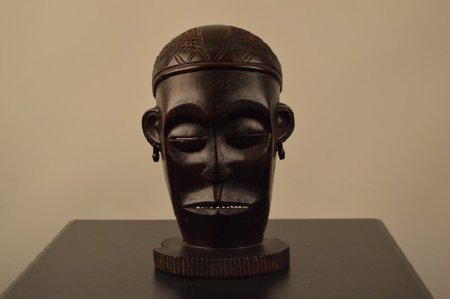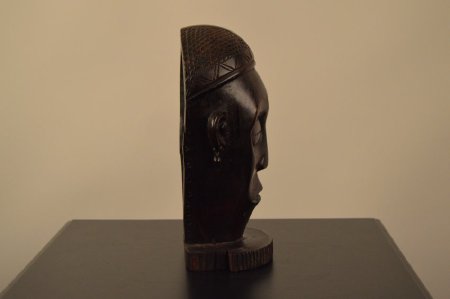Title:
Male Dance Mask
Object Name:
Mask, Ritual
Other Name:
Mask, Dance, Male
Place of Origin:
Chokwe, Angola, Africa
Provenance:
Aboriginal Indigenous Art.
H = 9—1/4"
W = 6"
D = 4"
Chokwe sculptors were the most famous of the region; there were two types. The songi made jinga charms, the small mahamba figures for the family shrines, and all objects used for hunting, love, magic, and fertility. In addition to the folk art, somewhat rigid and giving no illusion of depth, there existed also the ancient refined culture of the court, expressed with conviction by professional artists the fuli. They were hired by the great chieftainries and worked exclusively for the court. They sculpted scepters, thrones with figurines, fans, tobacco boxes, pipes, flyswats, cups, and figures of chiefs or ancestors – all demonstrating a great deal of refinement. They were famous for their large statues of deified ancestors, exalting strength and dignity. The best—known representation of a chief is of Chibinda Ilunga. He was a wandering hunter, youngest son of the great Luba chief Kalala Ilunga. He got married a Lunda queen Lueji. Chibinda Ilunga was the start of the sacred dynasty of the Mwata Yamvo of the Lunda and became the model of the hunting and civilizing hero, sometimes represented seated on a throne, sometimes as standing naked or dressed as a hunter. As statues of him were sculpted after the introduction of firearms, generally the standing figure is holding a stone rifle in his left hand and a stick, called cisokolu, in his right. Chibinda Ilunga’s body is stocky, with legs bent, shoulder blades clearly drawn, the neck wide and powerful, the navel protruding. He wears an enormous hairdo, the sign of princely rank. The social organization, founded upon matrilineal lineages, has an equally large number of female statues, whether these be identified as the queen mother or a chief’s wife.
The most powerful and important Chokwe mask is known as chikunga. Highly charged with power and considered sacred, chikunga is used during investiture ceremonies of a chief and sacrifices to the ancestors. These masks are made of barkcloth stretched over an armature of wickerwork, covered over with black resin and painted with red and white designs. Chikunga is worn only by the current chief of a group. The mukanda masks play a role in male initiation. The mukanda is an initiatory institution through which religion, art, and social organization are transmitted from one generation to the next. Mukanda training lasts from one to two years. Boys between the ages of about eight and twelve are secluded in a camp in the wilderness, away from the village. There they are circumcised and spend several months in a special lodge where they are instructed in their anticipated roles as men. As part of their instruction, the boys are taught the history and traditions of the group and the secrets associated with the wearing and making of masks. Mukanda masks are also made of barkcloth over an armature of wicker. They are covered with a layer of black resin, which can be modeled before it is ornamented with pieces of colored cloth.
H = 9—1/4"
W = 6"
D = 4"
Chokwe sculptors were the most famous of the region; there were two types. The songi made jinga charms, the small mahamba figures for the family shrines, and all objects used for hunting, love, magic, and fertility. In addition to the folk art, somewhat rigid and giving no illusion of depth, there existed also the ancient refined culture of the court, expressed with conviction by professional artists the fuli. They were hired by the great chieftainries and worked exclusively for the court. They sculpted scepters, thrones with figurines, fans, tobacco boxes, pipes, flyswats, cups, and figures of chiefs or ancestors – all demonstrating a great deal of refinement. They were famous for their large statues of deified ancestors, exalting strength and dignity. The best—known representation of a chief is of Chibinda Ilunga. He was a wandering hunter, youngest son of the great Luba chief Kalala Ilunga. He got married a Lunda queen Lueji. Chibinda Ilunga was the start of the sacred dynasty of the Mwata Yamvo of the Lunda and became the model of the hunting and civilizing hero, sometimes represented seated on a throne, sometimes as standing naked or dressed as a hunter. As statues of him were sculpted after the introduction of firearms, generally the standing figure is holding a stone rifle in his left hand and a stick, called cisokolu, in his right. Chibinda Ilunga’s body is stocky, with legs bent, shoulder blades clearly drawn, the neck wide and powerful, the navel protruding. He wears an enormous hairdo, the sign of princely rank. The social organization, founded upon matrilineal lineages, has an equally large number of female statues, whether these be identified as the queen mother or a chief’s wife.
The most powerful and important Chokwe mask is known as chikunga. Highly charged with power and considered sacred, chikunga is used during investiture ceremonies of a chief and sacrifices to the ancestors. These masks are made of barkcloth stretched over an armature of wickerwork, covered over with black resin and painted with red and white designs. Chikunga is worn only by the current chief of a group. The mukanda masks play a role in male initiation. The mukanda is an initiatory institution through which religion, art, and social organization are transmitted from one generation to the next. Mukanda training lasts from one to two years. Boys between the ages of about eight and twelve are secluded in a camp in the wilderness, away from the village. There they are circumcised and spend several months in a special lodge where they are instructed in their anticipated roles as men. As part of their instruction, the boys are taught the history and traditions of the group and the secrets associated with the wearing and making of masks. Mukanda masks are also made of barkcloth over an armature of wicker. They are covered with a layer of black resin, which can be modeled before it is ornamented with pieces of colored cloth.
Description:
Male dance mask with round cap. Geometric triangular designs in a band around a checkerboard hairstyle. Crescent—shaped ears with small round earlobes, almond—shaped protruding slit eyes, high arched eyebrows and wedge—shaped nose. Broad double bowed lips with jagged teeth. Flat beard broken and missing on right side, blackish brown patina.
Collection:
Finley Collection
Material:
Wood
Used:
Ritually Used
Technique:
Carving
Owned:
Art Department, Missouri Southern State University
Accession#:
2014.1.12



